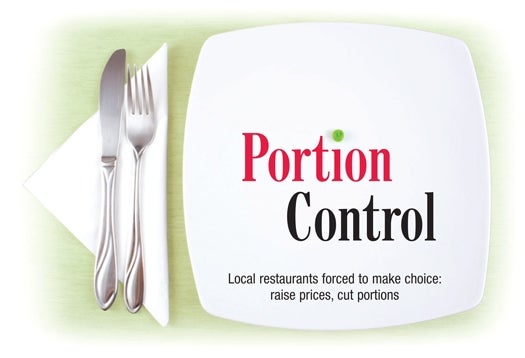With fuel and food prices spiking in recent months, restaurants have few options and most involve raising prices.
However, cutting portions is also on the table, whether it means serving less food for the same prices, less food for lower prices or even less food for slightly higher prices.
Slice And Dice
Steve Greene, co-owner of Tribeca restaurant on Shrewsbury Street in Worcester, said the young eatery chose to shrink portions and prices. By either cutting portions and leaving prices alone, or just raising prices, restaurants run the risk of alienating fickle customers.
Those customers have plenty of restaurant options in and around Worcester. So, Tribeca turned a sizeable portion of its menu over to what it calls âsmall plates.â
âWe considered raising prices,â Greene said. âBut we decided to cut down to smaller portions and smaller prices.â The small plates range from about $4.95 to about $8 and allow the restaurant to give customers closely guarding their wallets what they want. âIt’s actually gone over pretty well,â Greene said, âespecially late at night or at lunch in the afternoon. At dinnertime, I don’t see a lot of people ordering those types of meals, but definitely in the in-between times.â
It may not be a slam dunk for a new restaurant battling rising food costs, but it does do something even more important in the restaurant industry; it keeps customers at the table and buying, even if it means they’re spending less.
Mushrooming Prices
Keeping customers at the table hasn’t been a problem for the Flying Rhino, also on Shrewsbury Street. According to Paul Barber, the restaurant’s owner, customer spending has remained steady even as the economy slumps and restaurant spending dips by as much as 5 percent across the industry.
Barber said he began noticing the stress increasing food costs were putting on the restaurant in October and November. âSales have been staying the same,â he said. âIt was the stuff coming in the back door. You have to pass it on.â
In March, the Flying Rhino revamped its menu. Barber said, âwe were due for a menu revamp anyway, every year we try to do one, but because of how things were going, we brought the printing (of the menus) in the building.â
Now, in addition to saving money on printing, Barber can change the Flying Rhino’s menu at will. And in March, he certainly did. He knew price increases were necessary, but like Greene, he realized that surprising customers with a noticeable, across-the-board increase would’ve been suicide. Unlike Tribeca, the Flying Rhino’s menu is large, eclectic and easy to adjust without making wholesale changes.
So, Barber, who spent approximately $600,000 on food last year, went through the menu item by item. Any item other than steaks that would have required a price increase between $2 and $3 to make an acceptable margin is not on the new menu. âIf it was an item where we could do a buck, we did a buck,â he said. The next time Barber remakes the menu, perhaps the items that were taken off in March will make a comeback, $2 or $3 increase and all. Perhaps by then, the economy will be on the upswing.
âIt was very hard,â Barber said. âWe didn’t want to change our theme or go with smaller portions.â
The restaurant did manage to cut prices on a few items, as well. Barber said one of every two similar menu items was changed by using fewer or cheaper ingredients to allow for a lower price. For example, what was formerly a Portobello strudel appetizer that used apples and nuts was replaced by a Portobello stuffing that uses neither of those pricy ingredients. The restaurant also took the bottles of Fiji water off its tables.
âWe moved it behind the bar,â Barber said. âSales went down in bottled water, but I think that’s an indication of not shoving it in people’s faces. It’s a sign of the times, and it wasn’t what I wanted to be if the economy was going south. Also, food costs; they got stolen.â
So far, Barber’s strategy seems to have paid off. He said he expects the Flying Rhino’s 2008 food costs to decrease by 4 percent compared to 2007 as a result of the new menu. And per-person spending at the restaurant has so far held steady this year.
He said spiking energy costs may be more difficult to deal with. âThat’s very tough. I had to take it out of my advertising budget, but I know my $2,000 electric bill in the summer is going to be $3,000.â
Party Of 200
The Metro 9 Steak House in Framingham hasn’t raised its prices or cut portions. Yet, owner Peter Sarmanian expects food costs for his three restaurants â Metro 9, The Asgard in Cambridge and Kinsale in Boston â to drop by about 3 percent this year.
On certain days of the week, Sarmanian’s Classic Restaurant Concepts offers a prix fixe menu, which pre-assembles three or four courses for a set price nightly. A prix fixe menu is a bit more affordable for customers with less disposable income, Sarmanian said, and is much more economical for restaurants.
But the real savings for Classic came as a result of joining the Dining Alliance, a group purchasing organization that includes members from about 200 Boston-area independent restaurants. Being part of a group gives restaurants the power to negotiate the price of food and other supplies. Sarmanian said his three restaurants spent a combined $2.8 million on food last year. Along with a 3 percent decrease in food costs this year, he expects an even more impressive is the 15-18 percent decrease on non-food items like containers, linens and cleaning products.

